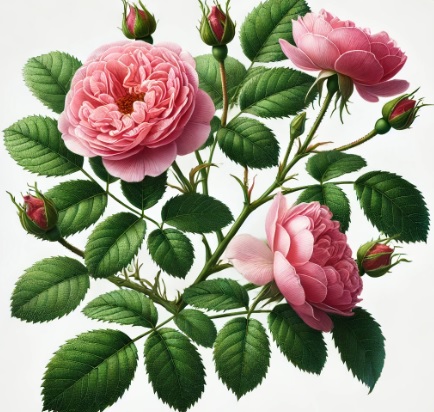Bourbon rose (Rosa borboniana) is a species of rose that originated on the island of Bourbon (now Réunion) in the Indian Ocean. This rose is renowned for its stunning and fragrant blooms, which typically feature a range of colors from pink to red. The Bourbon rose is a bushy shrub that exhibits a vigorous growth habit and continuous flowering throughout the growing season. It is prized in gardens for its beauty and is well-suited for both formal and informal landscape designs.
Botanical Classification:
Kingdom: Plantae
Order: Rosales
Family: Rosaceae
Genus: Rosa
Species: Rosa borboniana
Plant Characteristics:
Rosa borboniana is characterized by:
Medium to large flowers with a range of colors, including pink, red, and sometimes white
Rich, spicy fragrance that enhances its ornamental appeal
Dense, dark green foliage that provides a backdrop for the blooms
Bushy growth habit, typically reaching heights of 4 to 5 feet with a similar spread
Chemical Composition and Structure:
The chemical composition of Rosa borboniana includes:
Essential oils containing aromatic compounds such as citronellol, geraniol, and eugenol, contributing to its characteristic fragrance
Flavonoids and tannins in the petals and leaves, offering antioxidant and astringent properties
Anthocyanins responsible for the flower's coloration, providing additional antioxidant benefits
Uses and Benefits:
Aesthetic: Highly valued in gardens and landscapes for its beautiful, fragrant blooms and continuous flowering.
Cosmetic: Extracts are used in skincare products and perfumes for their hydrating, soothing, and aromatic properties.
Medicinal: Traditionally used in herbal remedies for its astringent and soothing effects, though scientific research is limited.
Culinary: Petals can be used to flavor teas, desserts, and other culinary dishes, adding a subtle floral note.
Applications:
Gardening: Used as an ornamental shrub in garden beds, borders, and containers, appreciated for its lush foliage and prolific blooming.
Cosmetics: Extracts are incorporated into creams, lotions, and perfumes for their beneficial properties and pleasant fragrance.
Culinary: Fresh or dried petals used in culinary preparations and infusions.
Environmental and Safety Considerations:
Environmental Impact: Non-invasive and adaptable to various soil types and conditions; supports pollinators such as bees.
Safety: Generally safe to handle; however, individuals with sensitive skin should exercise caution to avoid potential allergic reactions.
INCI:
Skin conditioning agent. It is the mainstay of topical skin treatment as it has the function of restoring, increasing or improving skin tolerance to external factors, including melanocyte tolerance. The most important function of the conditioning agent is to prevent skin dehydration, but the subject is rather complex and involves emollients and humectants that can be added in the formulation.
Synonyms:
CAS: 97660-07-6 EC number 307-515-2
![]() Bourbon rose
Bourbon rose 

